The second weekend of the 2022 NWSL Challenge Cup gave us another opportunity to examine the twelve teams and begin to see which will do well and which could struggle. North Carolina Courage have been one of the standout sides so far and were looking to build on their opening round win against NJ/NY Gotham. The visit of Orlando Pride, who could only manage a goalless draw at home to Washington Spirit last time out, looked like a good opportunity to do so. Both clubs have permanent managers once again, with Amanda Cromwell appointed as now-Manchester United Women boss Marc Skinner’s replacement at the Pride, whilst Sean Nahas saw his interim term made permanent after stepping in to lead the Courage last October.
This tactical analysis will break down the performances of both sides, specifically detailing Orlando’s play out of possession and the issues they had when looking to attack forwards. The analysis will also focus on North Carolina’s tactics, explaining how they looked to beat Orlando’s low block.
Lineups
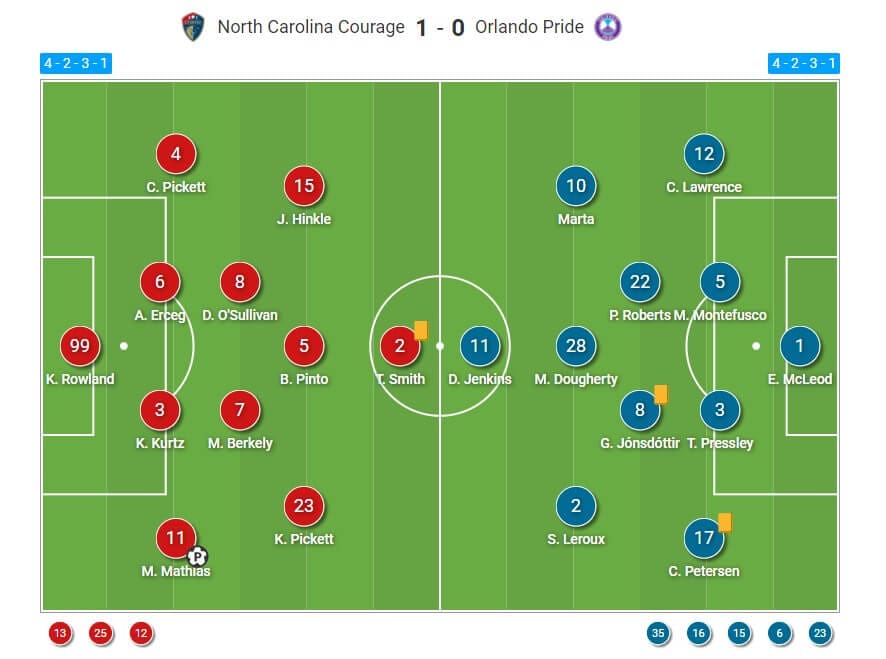
North Carolina Courage made just one change to their starting formation, with Sean Nahas opting to play with a 4-2-3-1 and not the 4-2-2-2 that he had used against Gotham. Brazil star Debinha was left out of the squad and replaced by Kiki Pickett, who started as the right winger, whilst Brianna Pinto was given the playmaker role and Jaelene Daniels (née Hinkle) started on the left. Taylor Smith was given the central striker’s role, whilst Katelyn Rowland continued in goal with regular stopper Casey Murphy still injured. New Zealand centre-back Abby Erceg once again had the armband.
Orlando Pride also opted for a 4-2-3-1 for this game, having played in a 4-4-2 against the Spirit. They made three changes to their starting XI, with defender Amy Turner, midfielder Mikayla Cluff and Wales international Angharad James all dropping out. Toni Pressley came in to form a new central defensive partnership with Megan Montefusco (née Oyster), whilst midfielders Parker Roberts and Meggie Dougherty Howard were also given their first starts of the season. Captain Marta took up a wide forward position, whilst the experienced Sydney Leroux offered just as big a goal threat from the left-hand side, both supporting lone striker Darian Jenkins.
North Carolina Courage’s tactics
As mentioned, North Carolina Courage were looking to build on their win last weekend, with Sean Nahas using these games to implement his interpretation of Johan Cruyff’s “total football” philosophy, and their two games so far have seen players operating in different roles around the field. The aim of this appears to be achieving a better level of versatility that will help them to adjust to different situations.
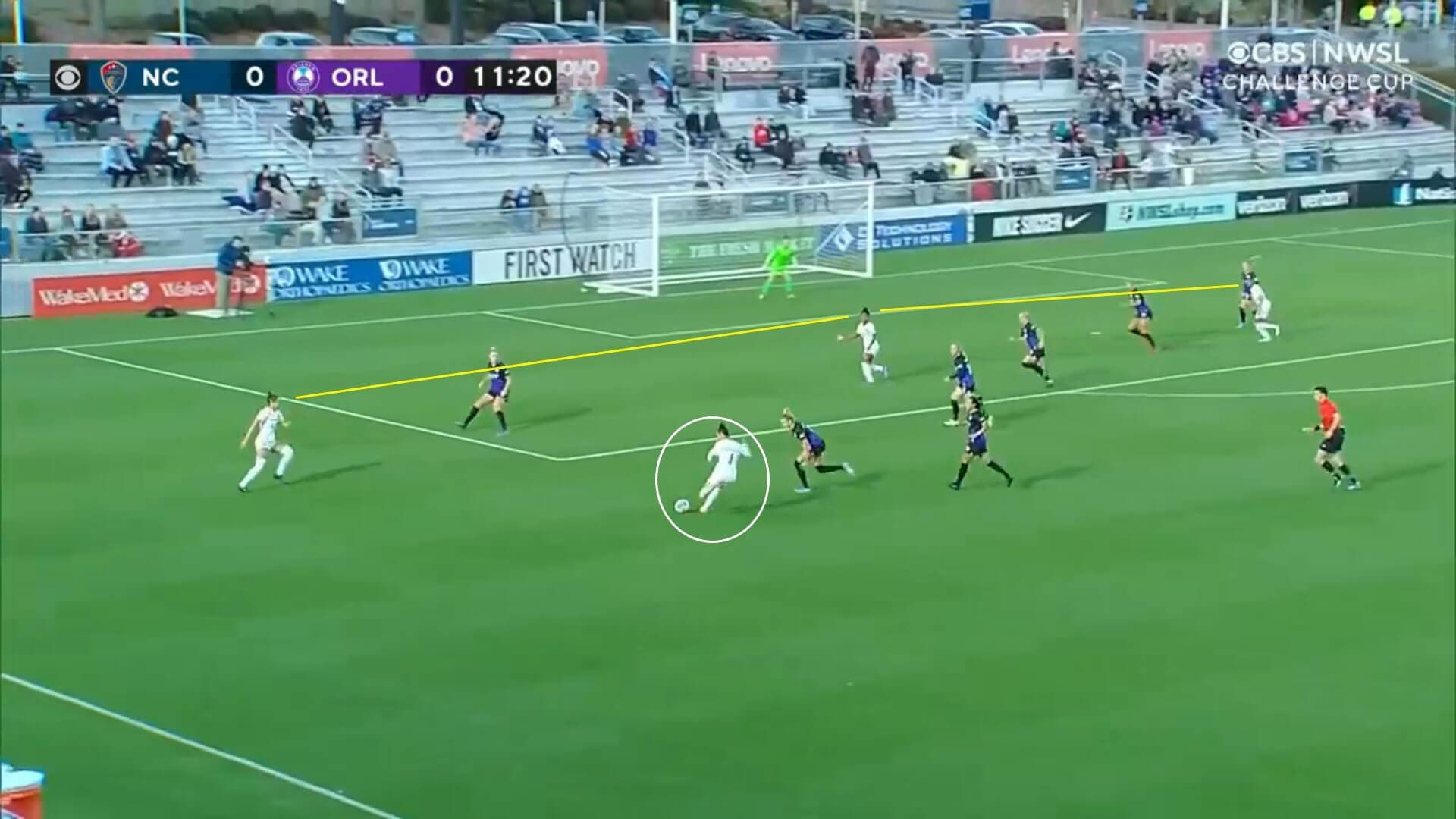
With regards to this, the two full-backs, Merritt Mathias and Carson Pickett, were asked to get up the pitch as normal, but to take up more central positions than they did last year. As a result, it was common in this game to see them in the half-spaces, just as Pickett is in this image. These are very difficult areas to defend against, as we know, and effectively gave North Carolina two playmakers who could link-up with teammates either in the central areas or on the wings, giving them more opportunities to create chances.
However, in order to balance this out, those in the wide forward roles were asked to stretch out and move towards the wings, and the advantage of this is that Orlando Pride’s defensive line also stretched out in order to limit the Courage’s threat from the wings. However, in doing so, they left gaps open between the individual defenders for the home side to exploit, with this image demonstrating Brianna Pinto doing just that.
She often played as a false nine in this game and was involved in a lot of their attacking play in the first half, maintaining the pressure on Orlando and giving her team a good passing option in forward areas. With this structure in place, Carson Pickett now had space and time to play the ball into Pinto, leading to them getting a shot away on goal.
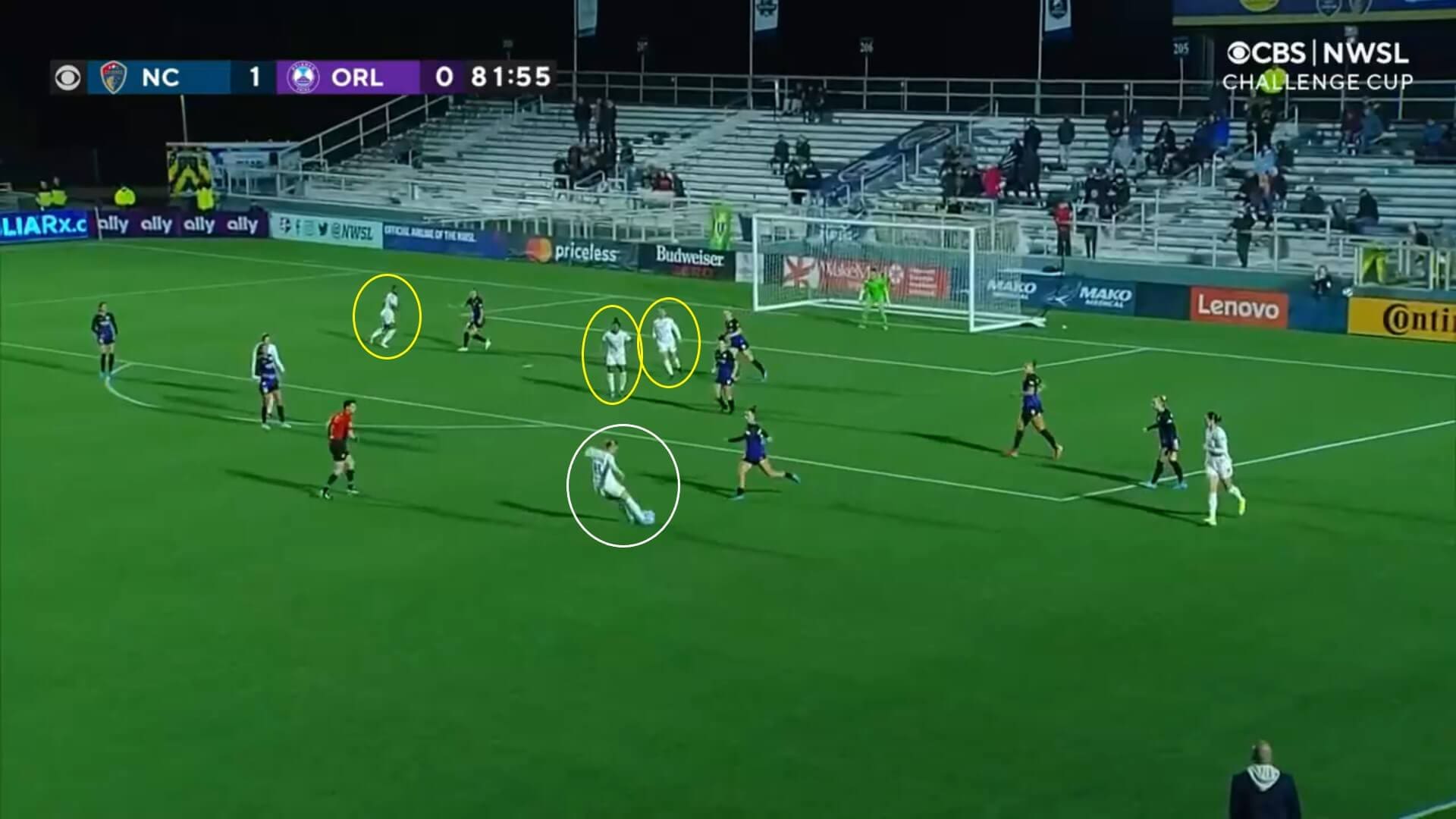
However, whilst this tactic did lead to North Carolina controlling the general flow of proceedings in this game, they did lack quality with their final passes at times, and this was why their possession didn’t turn into any goals from open play. It was often the case that, when they got into these areas and looked to set up a shot in the box, the full-backs were caught in two minds as to whether to cross into a teammate or shoot at goal themselves, given that they were in dangerous areas of the pitch.
It did seem in this game that they haven’t yet adapted to the shorter distances between them and their teammates yet, with both used to crossing into the box from the wings. In this case, Mathias has three players ahead of her, but ends up overplaying her cross and sending it harmlessly out of play for a goal kick. Therefore, if this is something that Sean Nahas intends to persevere with, then he needs to work on the weight of passes and ensure that they can be as productive as possible.
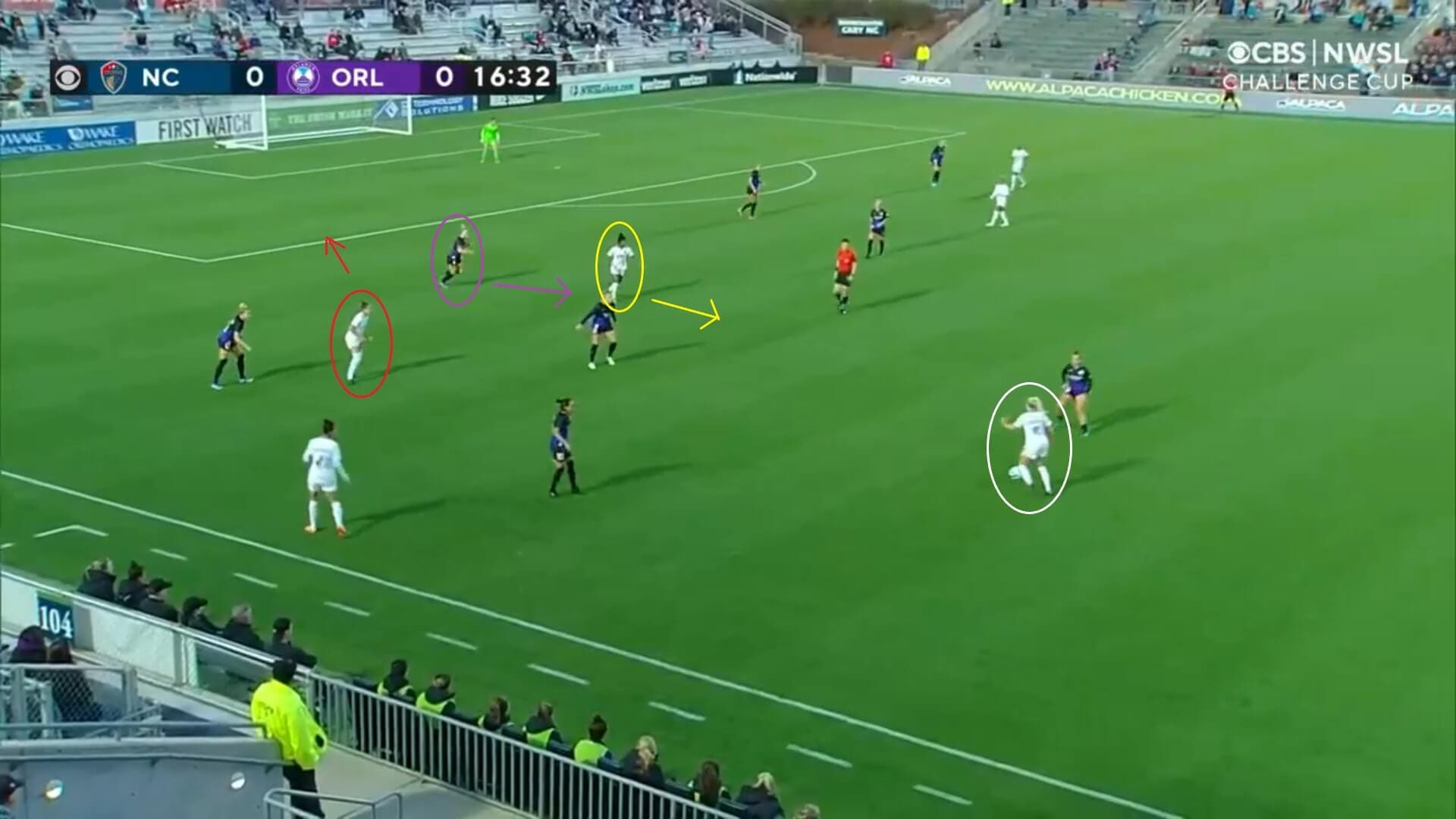
Another way that North Carolina looked to break through Orlando’s defensive setup was to draw their players out of position, as has happened here. Republic of Ireland midfielder Denise O’Sullivan has played a short pass into Pinto, in the yellow circle, who is dropping back and being followed by Orlando defender Megan Montefusco, who looks to close her down and win the ball back. However, in doing so, she has come out of line and left a hole for Daniels to run into, as shown by the red arrow, and this would have ended in a potential goal without right-back Carrie Lawrence getting back to make a crucial block.
A lot of North Carolina’s good play originated from O’Sullivan, and she was key to their positive play throughout the encounter, acting as a deep-lying playmaker and constantly looking to disrupt Orlando’s rhythm, and this was another reason that the Pride struggled to build any momentum.
The overall point to take from this is that, even when it looked as if Orlando were impenetrable, the Courage always seemed to find a way, and this will be really promising for a side who struggled at the back end of last season and only secured their playoff place on the final day of the regular campaign.
Orlando Pride out of possession
Whilst North Carolina Courage had good attacking tactics that allowed them to get up the field and play with good ball movement, Orlando Pride opted for a defensive approach, looking to limit their opponents’ attacking threat and keep them at bay for as long as possible.
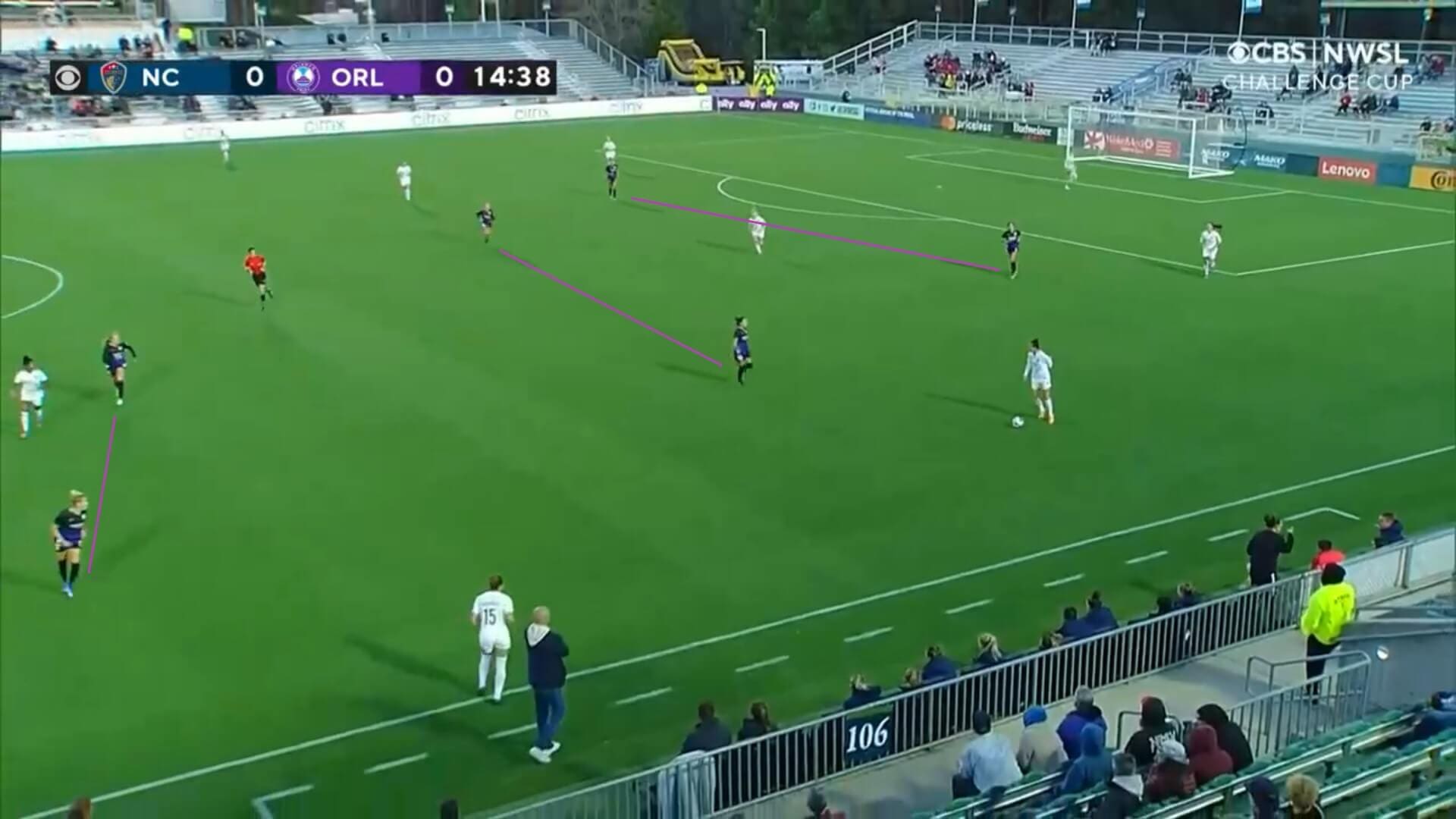
It was noticeable that their starting 4-2-3-1 morphed into a 4-2-2-2 when out of possession, especially in the first half. This was because the players formed partnerships around the pitch and worked together to limit the spaces that the home side could play into. Looking at the first two lines, made up of Sydney Leroux and Darian Jenkins ahead of Marta and Meggie Dougherty Howard, their role was to stretch out and force the Courage to pass the ball out to the wings, where attacks can be more easily defended against. This was a setup that we saw a number of times in the first half and shows a good basic idea of defensive play.
Once the ball had been moved out to the wing, the lack of options available to North Carolina meant that Orlando could more easily predict which player would next receive the ball; in this case, Daniels is standing on the nearside line. However, the third Orlando line, composed of Parker Roberts and Lawrence, can now drift across and look to close off the space for Daniels to operate in before she gets the ball, therefore forcing her to take the ball into an area where the Pride have a better chance of regaining it.
What we can take from this is that, even though they didn’t have as much possession as their opponents during the game, Orlando still worked hard to dictate large parts of it and tried to force their opponents into making mistakes with their transitional play.
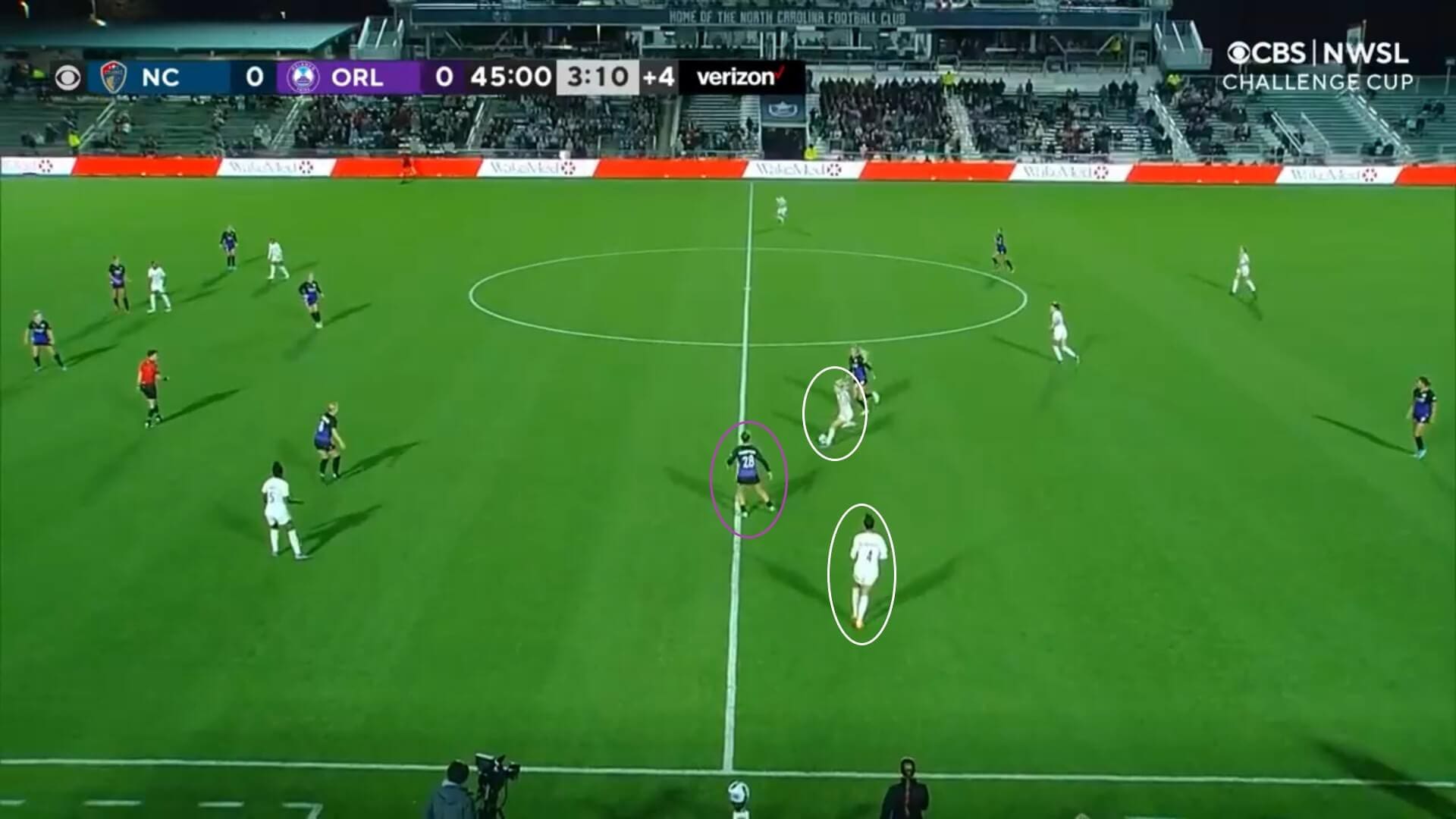
However, this tactic didn’t work the same way once Marta had gone off injured, with her replacement, Mikayla Cluff, not the same type of player. Whilst Marta tends to play as a forward or a second striker, Cluff is a more traditional central midfielder, so there wasn’t the same intensity to press as there had been beforehand. As a result, situations like this began to happen, with Dougherty Howard, in the purple circle, on her own against both O’Sullivan and Carson Pickett.
With their players dropping back more and not showing as much desire to get forward, Orlando also lost their defensive width, giving North Carolina more space to play in as a result. North Carolina could now link up more players in the central areas and create numerical overloads like this one, and this was one reason for the home side having more control of the game.
Comments made after this encounter by fans and writers suggested that Orlando were never in it, which is not strictly true. In the early stages, they did look like taking something from the match, with their setup causing their hosts a few problems. However, that ended with the loss of talismanic captain Marta, which affected them in more ways than perhaps first met the eye.
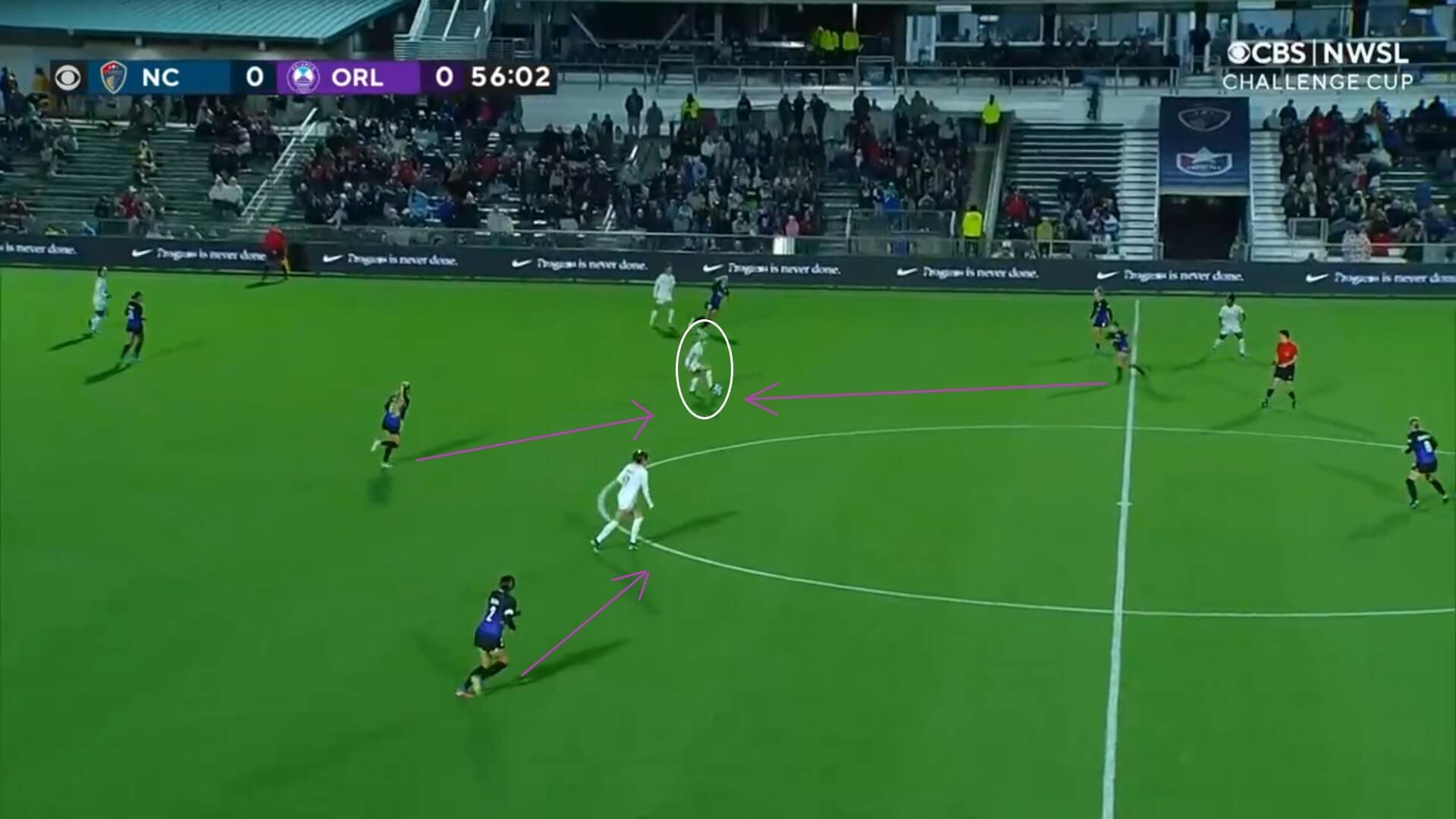
Seeing that her side had been struggling, Amanda Cromwell made two changes at half-time to introduce extra experience, with midfielder Angharad James and ex-Atlético Madrid Femenino right-back Kylie Strom coming on for Roberts and Lawrence. This immediately gave Orlando more urgency around the field, with Strom anticipating and clearing long balls played into the box by North Carolina, whilst former Everton Women and Reading Women midfielder James worked hard to press individual opponents and give the defence better protection.
As a result of these changes, North Carolina no longer had the same time on the ball that they had been afforded in the first half, with James and Cluff pressing O’Sullivan here from both sides, whilst the next player to receive the ball is also being closed down by Leroux. Orlando did still struggle to get into the game, but they looked more dangerous and did manage to create a few chances at the end of the second half, and these substitutions were one reason for that.
Orlando Pride’s mistakes with the ball
However, whilst their work without the ball was positive overall, they were let down by mistakes made in possession. Most of these were fairly simple errors, meaning that they can be easily fixed, but addressing some of the basics of their game will be critical in Orlando securing a first win of 2022 sooner rather than later.
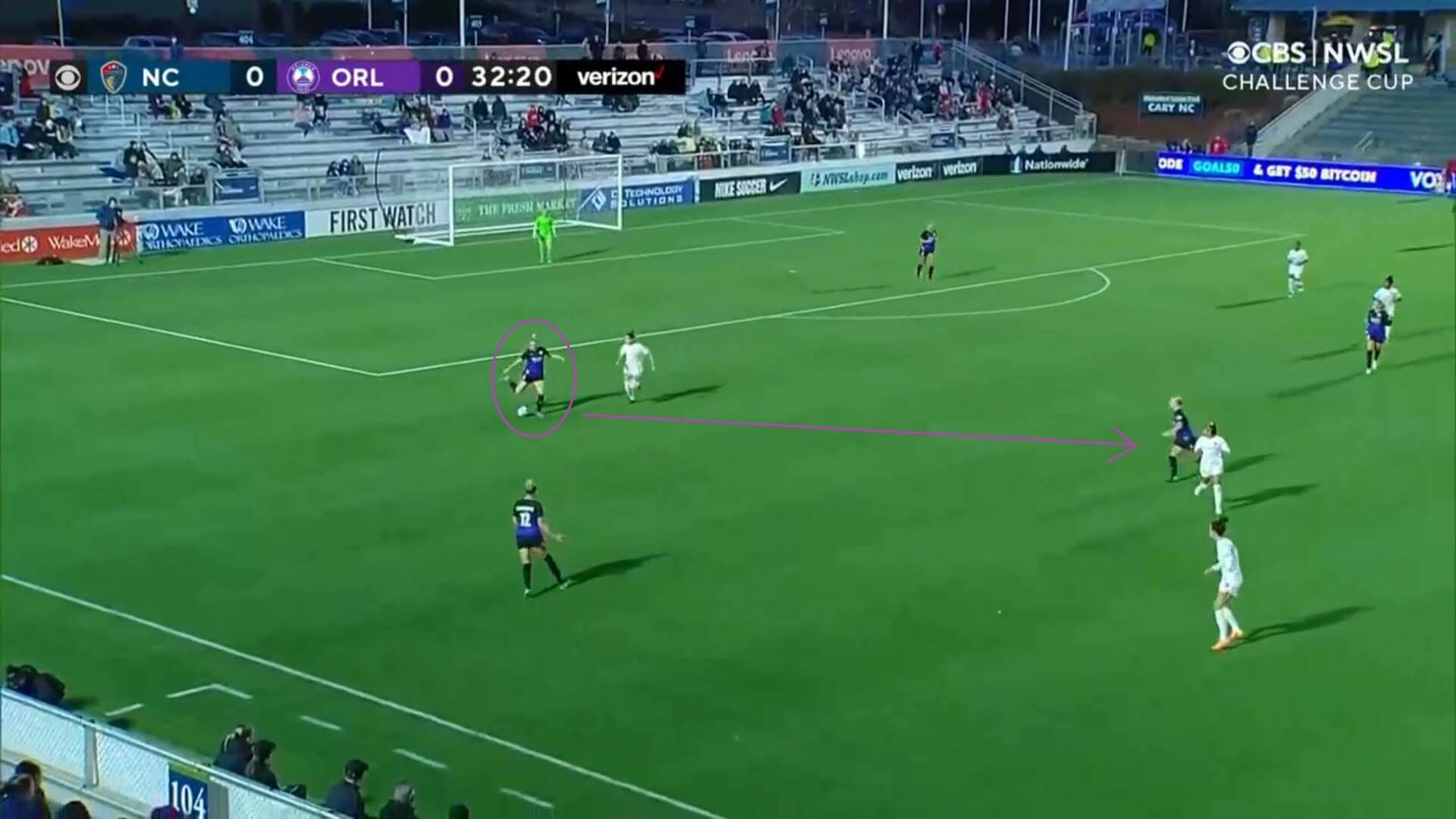
It was notable in some moments that they had too much time on the ball, and this image shows one time when this let them down. Here, the defenders are transferring the ball across the pitch and looking for a route to play it forwards. Now that an opportunity has opened up, with Gunnhildur Jónsdóttir available, Montefusco makes the pass but manages to overhit it, leading to the ball going beyond the Iceland international and being collected by North Carolina Courage, who were then in a good position to launch an attack.
It is clear that Montefusco was being closed down by a Courage attacker, but this is just one player and Orlando should be able to play around her, so this mistake still comes down to poor care of the ball.
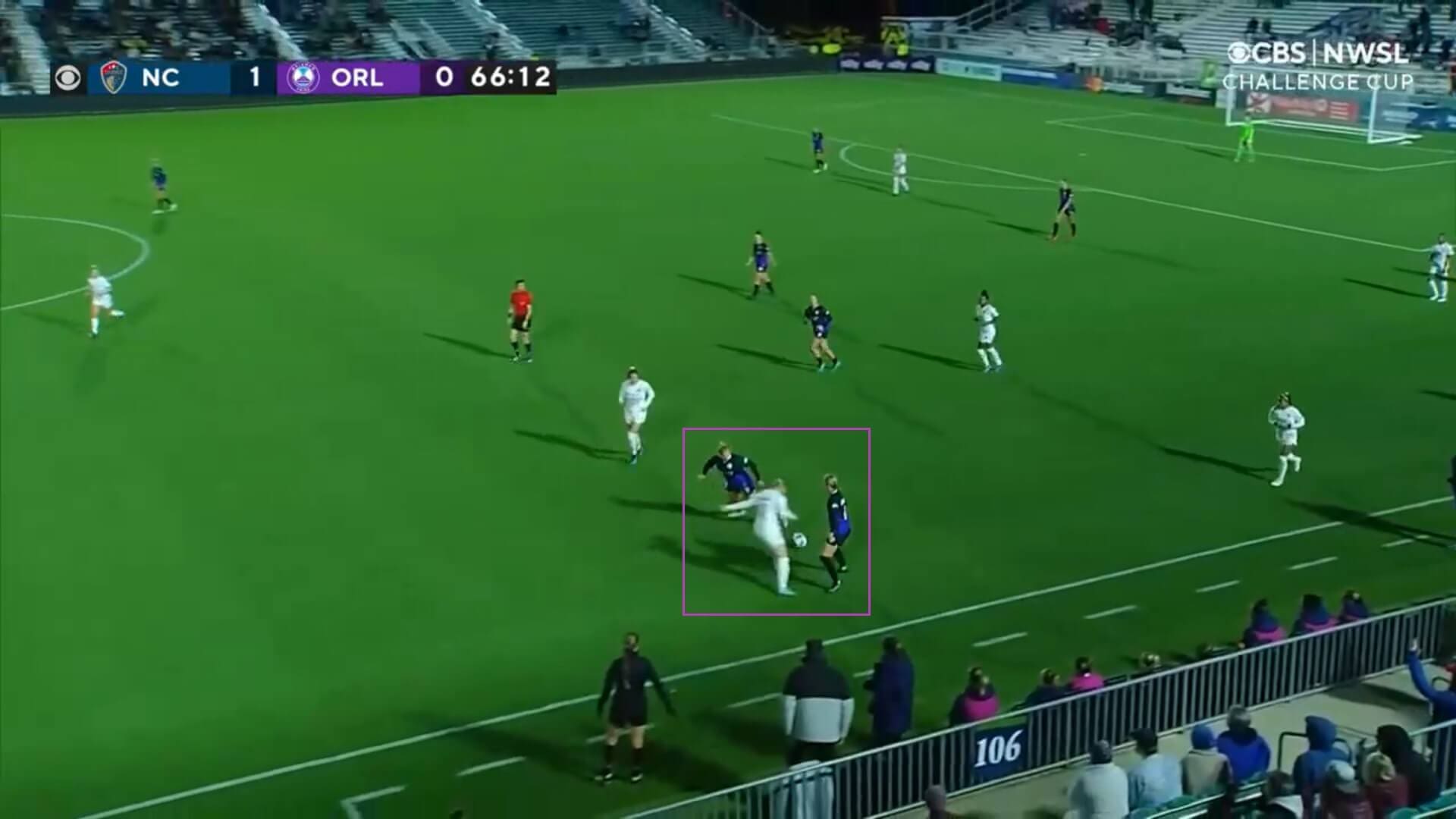
This was a running theme throughout the match, with Orlando looking to build an attack here after several good passes to open up this opportunity. However, once Mathias gets tight to Jónsdóttir here, she loses her composure and the pass into forward Leah Pruitt goes too far, with home midfielder Malia Berkely winning it and beginning a period of sustained Courage possession in the Pride’s half.
It is common knowledge that North Carolina are a team who like to press and win the ball early, with Cromwell referencing this in her pre-match comments, and she would have wanted her team to not give the ball up too easily or in dangerous situations. This example was both of those, and it again shows how Orlando were at times their own worst enemies.
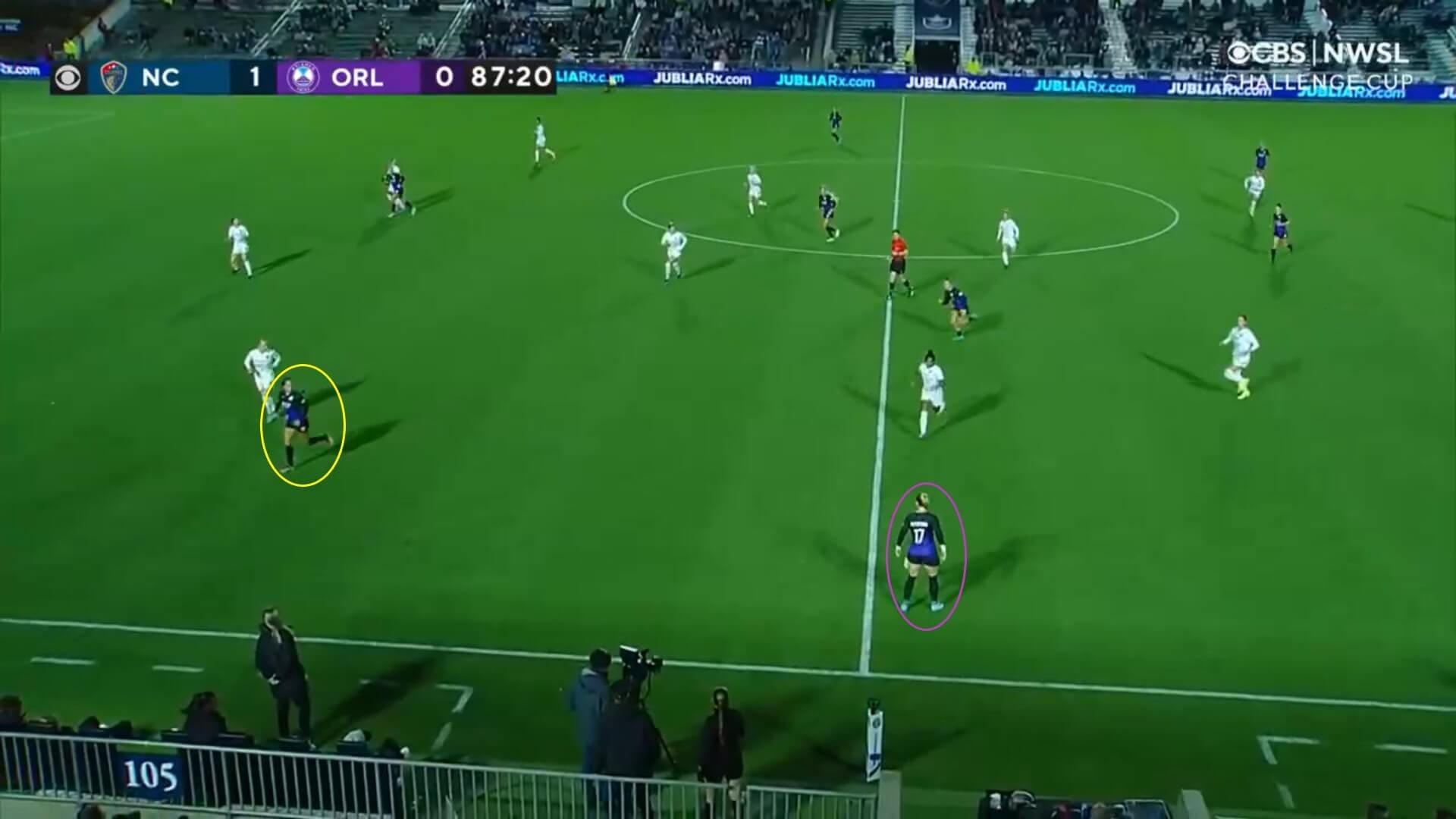
This image comes back to the Pride again having too much time to think and not releasing the ball at the right time. In this case, left-back Courtney Peterson has made a good run up the pitch, as she is known for, and receives the long goal kick from Canada goalkeeper Erin McLeod. In order to help keep the ball moving, Leroux is moving towards the wing and into a position where she can receive a pass from Peterson.
However, Mathias is moving to close her down, just as she did in the previous example, and Peterson needed to play the pass into Leroux with either her first or second touch in order to prevent the space behind her teammate being closed off. However, because she held onto the ball for a fraction too long, Leroux was forced to run inside the pitch and into an area where Kiki Pickett could tackle her and end the threat.
It does look as if we are being overcritical about the smallest details in Orlando’s performance, but football games are won or lost in moments like this, and the fact that the Pride were outplayed in this game, according to various post-match reports, means that they need to tidy these areas up in order to get their so far lukewarm Challenge Cup campaign going.
Conclusion
In conclusion, this tactical analysis has looked at the many reasons for North Carolina Courage edging Orlando Pride in this Challenge Cup fixture. In truth, it was not a game that will live long in the memory, but North Carolina will nevertheless be pleased with a second consecutive victory in what was an up-and-down performance, according to Sean Nahas, plus they still have the record of being the only team yet to concede a goal.
Orlando Pride, meanwhile, were trying out some new tactics and looking to develop their game, and, by Amanda Cromwell’s admission afterwards, what they did try didn’t quite pay off here. However, as we have shown in this analysis, there is potential in what they were trying to do, and it just comes down to practice and being better at the little things during matches, so there is hope yet.
Both sides are back in Challenge Cup action in midweek. North Carolina are on the road for the first time, as they visit the NWSL’s defending champions Washington, whilst Orlando are back at home and host Gotham, with those two fixtures completing the first half of the group stages.





Comments